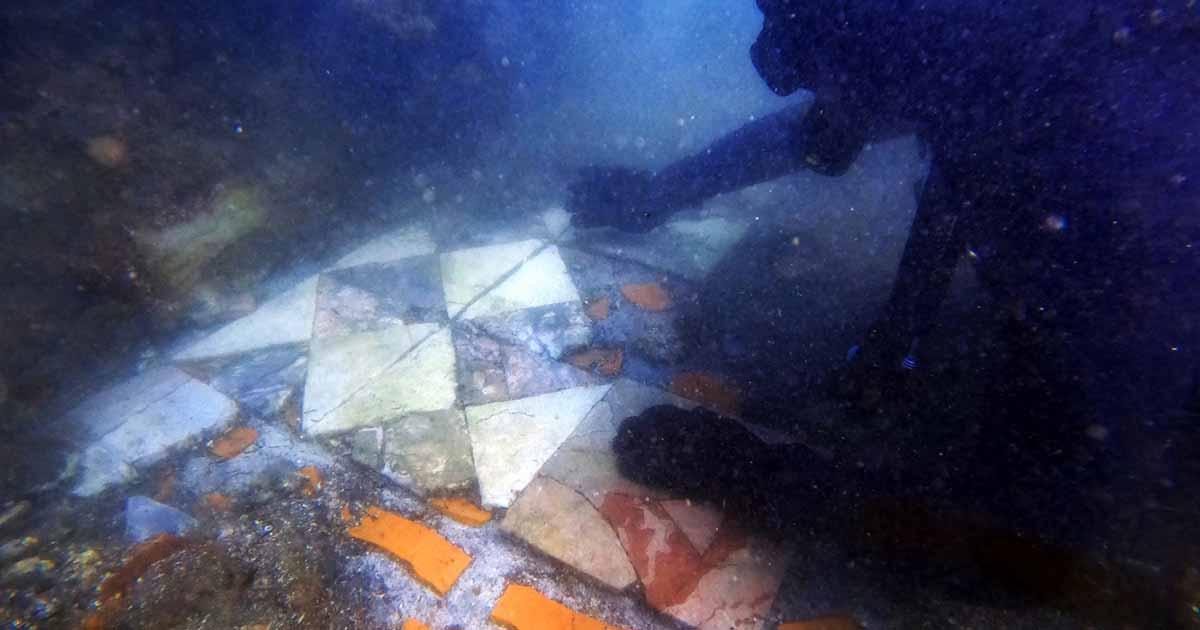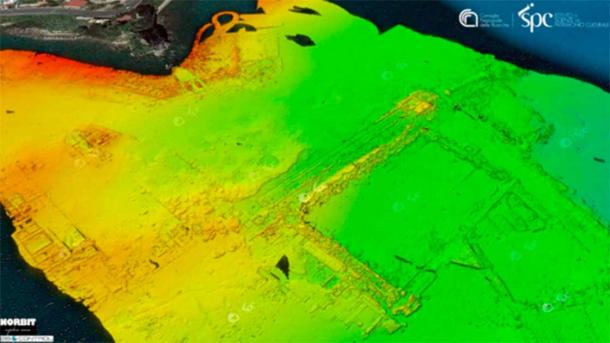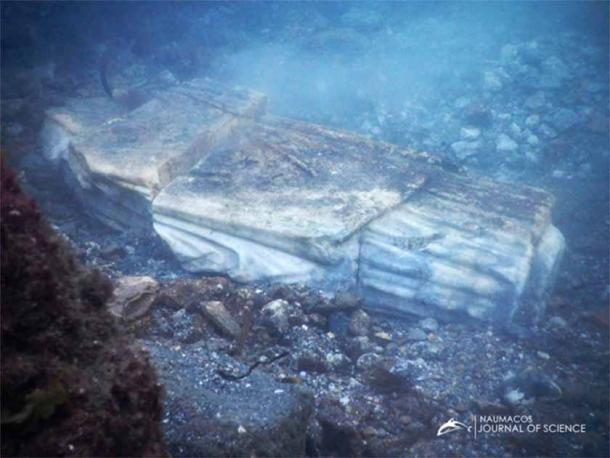
Stunning Roman Villas Unearthed in Underwater Ruins of Ancient Baiae
Underwater archaeologists working in the shallow waters of the Gulf of Naples, off Italy’s western coast, recently discovered the ruins of spectacular Roman villas. Built 2,000 years ago, or possibly even a little earlier, these underwater remains are part of the legendary remains of Baiae, known in modern times as the Las Vegas of the ancient world.
During a seafloor scan of the lower section of Baiae, an ancient Roman resort village that was once frequented by Rome's elite, archaeologists discovered a previously unknown set of structures covering over 260 feet (80 meters) of space.

Scan of the ruins discovered underwater at Baiae. (Naumacos / Campi Flegrei Archaeological Park)
Exploring Recent Discoveries in the Underwater Ruins of Baiae
Some of the buildings spotted underwater had collapsed, revealing interior contents that were consistent with their identification as Roman villas, which were country houses that belonged to Rome’s rich and famous. The discovery of the new stretch of Roman ruins was announced in a press release issued by Campi Flegrei Archaeological Park, which manages all tourist activity at the ancient Baiae site.
- 10 Sensational Sunken Kingdoms: Atlantis’ Companions Beneath the Waves
- Underwater Archaeologists Discover Submerged Ruins off the Coast of Naples
Among the submerged wreckage of these lost structures, the archaeologists observed several intact marble columns, including a column made from rare Portasanta marble that would have been imported from the island of Chios in Greece. They also spotted many stone colonnades, which are rows of columns arranged to support heavy roofs.
They were especially excited to discover an extended section of exposed of marble flooring. The marble tiles of the floor were made from both white and Portasanta marble squares, which were arranged in an alternating pattern.

Among the submerged at Baiae, the archaeologists observed several intact marble columns. (Naumacos / Campi Flegrei Archaeological Park)
Sunken Roman Villas at Baiae, the Las Vegas of Ancient Rome
Underwater archaeologists affiliated with the park, in collaboration with colleagues from Naumacos Underwater Archaeology and Technology, were conducting a survey in an area occupied by a thermal bathing complex when they found the ruins of the sunken Roman villas. It was hardly surprising to find these homes so close to an ancient bath, since Roman elites were known to frequent these establishments.
Often called the Las Vegas of ancient Rome, the resort community of Baiae was built on the Cumaean Peninsula on the northwestern coast of the Gulf of Naples, just a few kilometers from Pompeii. While Baiae was not destroyed by a volcanic eruption like Pompeii, it was still located in a volcanically active area, and the movement of magma in the earth caused the lower half of Baiae to gradually sink beneath the sea between the third and 16th centuries.
The underwater ruins of Baiae are part of Campi Flegrei Archaeological Park and are open to snorkelers and scuba divers. These intrepid underwater adventurers will now have a new spot to explore thanks to the latest amazing discoveries.
Baia is home to the most spectacular submerged treasure in the Mediterranean, its ruins have slowly sunk into the Bay of Napoli over the centuries because of the region’s frequent earthquakes. (Photo by Pasquale Vasallo) pic.twitter.com/w7SEcmumpY
— Archaeology & Art (@archaeologyart) October 30, 2021
The Story of Baiae: Rome’s Most Decadent Elite Retreat
Celebrated as perhaps Rome’s most luxurious vacation destination, Baiae first rose to prominence in the late Republican era. The village was named after Baius, a character from Homer’s epic poem the Odyssey who served as helmsman on Odysseus’s ship and was even said to have been buried somewhere close to the Gulf of Naples.
At the height of its fame, Baiae was well-known for its beautiful beaches, gorgeous landscape and fabulous architecture. It was also known for its extreme hedonism and dedication to the most outrageous forms of vice.
Interestingly, the decadence of Baiae seems to have reached its peak not in the declining days of the Roman Empire, which is so often associated with self-indulgence and disreputable behavior among the wealthy. Instead, it was during the latter stages of the Republic when the whims of the rich and famous were indulged so freely at Baiae and without any concern for propriety.

This was during the resort town’s earliest days (Baiae was founded around 100 BC). Historians of the underwater site have concluded that over time the village evolved into a more eclectic getaway where Roman leaders and aristocrats could party as hard as they wanted or enjoy restful and relaxing vacation if that was their preference.
The names of the individuals who spent a significant amount of time at Baiae is a virtual who’s-who of the Roman Republican and Imperial eras. Julius Caesar had a villa there, as did Nero and Hadrian (the latter died in Baiae in 138). The emperor Septimius Severus visited frequently and considered it one of his favorite places. The infamous emperor Caligula was yet another elite figure who came to Baiae quite often, and he was responsible for an elaborate stunt that was remembered for decades.
In order to negate a prediction by the astrologer Thrasyllus that Caligula had “no more chance of becoming emperor than of riding a horse across the Gulf of Baiae,” the young emperor ordered the construction of a three-mile-long (4.8 km) pontoon bridge across that very same body of water. Wearing golden robes, Caligula crossed the entire bridge on horseback, thereby proving to the world - in his mind at least - that he was destined to become one of the Empire’s greatest leaders.

Marble and bronze sculptures featuring gods and humans have been uncovered in the underwater world of Baiae. (Naumacos / Campi Flegrei Archaeological Park)
Baiae: Delving into the Abundant Heritage of a Submerged Metropolis
Despite changing times and fashions, Baiae remained a popular oceanside resort in the Roman world for six centuries. It was first sacked during the barbarian invasions that devastated the Western Roman Empire, and then destroyed yet again by Muslim conquerors in the eighth century.
- Finding the Lost City of Heracleion: Encountering Myth Under the Waves
- Sunk by a Tsunami, Underwater Archaeologists Finally Find the Ruins of the Roman City Neapolis
Due to the ongoing volcanic activity in the area, the beachside section of the original village was mostly underwater by the end of the eighth century, although flooding had started to become a problem there as early as the third or fourth century.
Excavations and underwater surveys at the ancient Roman resort town began in earnest in 1941. Over the decades, archaeologists have uncovered an impressive collection of ruins at Baiae, dating back to the Roman Republican and Empire days.
These ruins have included vast temple complexes, fancy villas, large bath facilities, columns, plazas and marble and bronze sculptures featuring gods and humans well-known in the Greek and Roman ancient worlds. These ruins have been unearthed both on land and under the sea, with the latest Roman villa discovery representing one of the most eye-opening finds in recent years.
Top image: Underwater archaeologist exploring the ancient remains of Baiae. Source: Naumacos / Campi Flegrei Archaeological Park
By Nathan Falde
















Comments
Well, my friend, I’ll take credit for the alternative narrative if it’s pinned on me! But somebody in the field will hopefully also piece it together, and knock down the prevailing narratives (house of cards) that DO NOT FIT the hard evidence, which in most cases, require the ancient people to engage in strange, laborious activities for silly, afterlife considerations – NOT LOGICAL! A fallen/buried, pre-Roman civilization, ignored by the narratives, becomes an ABSOLUTE CERTAINTY!
Nobody gets paid to tell the truth.
Pete, the only person constructing a bankrupt narrative is you. With absolutely no evidence you yet again ride out on your delusional fact free ideas. There's YES evidence Romans built things, just as there is NO evidence to back up your Ice Age hypothesis. In fact, I'm pretty sure that if someone pointed out that most of the Northern hemisphere was covered in two kilometre thick ice sheets and thus no civilisation, no matter how advanced they were would've been able to build anything, would be poo pooed in your usual arrogant fashion!
This is a good example, among many, of evidence that completely destroys the Roman narrative. There’s no way that they would have constructed those complexes upon unstable land. The geologists could easily tell you that there’s no way that land sank like the narrative calls for. This construction was almost certainly completed during the early Ice Age, say 50k BC, when seas were much lower due to water locked up by the polar ice caps. It only looks ‘Roman’ because that’s what they call ALL the Atlantean era ruins around the Med. There’s NO evidence the Romans built anything but a narrative.
Nobody gets paid to tell the truth.